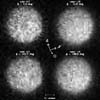| . |  |
. |
San Antonio - Aug 11, 2003 The long-held perspective that comets are pristine remnants from the formation of the solar system has evolved from the prevailing views of 30 years ago, finds planetary scientist Dr. S. Alan Stern in a paper published in the journal Nature. "It's fair to say that a sea change has taken place," says Stern, director of the Space Studies Department in the SwRI Space Science and Engineering Division. "We used to consider comets as wholly unchanged relics that had been stored ever since the era of solar system formation in a distant, cold, timeless deep freeze called the Oort cloud. We now appreciate that a variety of processes slowly modify comets during their storage there," he says. "As a result, it's become clear that the Oort cloud and its cousin the Kuiper Belt are not such perfect deep freezes." The first evolutionary process to be recognized as affecting comets during their long storage was radiation damage, followed by the discovery that sandblasting from dust grains in the interstellar medium plays an important role. Next, researchers theorized that comets in the Oort cloud are heated to scientifically significant temperatures by passing stars and supernovae, says Stern. More recently, researchers are finding that comets in the Kuiper Belt are heavily damaged by collisions. "It also now seems inevitable that most comets from the Kuiper Belt, though constructed of ancient material, cannot themselves be ancient -- instead they must be 'recently' created chips off larger Kuiper Belt Objects, formed as a result of violent impacts," says Stern. "This is truly a paradigm shift. Many of the short-period comets we see aren't even ancient!" The classical view that comets do not evolve while they are stored far from the sun in the Oort cloud and Kuiper Belt began to change as far back as the 1970s, but the pace of discoveries about the way comets evolve picked up considerably in the 1980s and 1990s. As a result of these findings, astronomers now better appreciate that comets, though still the most pristine bodies known, have been modified in several important ways since their birth, says Stern. The realization that comets evolve during their long storage in the Oort cloud and Kuiper Belt provides insight and context to more confidently evaluate the results of astronomical and space mission observations of comets. So, too, it suggests that cometary sample return missions now on the drawing board for NASA should employ relatively deep subsurface sampling if truly pristine, ancient material is to be collected. Related Links South West Research Institute SpaceDaily Search SpaceDaily Subscribe To SpaceDaily Express
 Washington - Aug 11, 2003
Washington - Aug 11, 2003It begins with a faint trace of light that besmirches an astronomer's otherwise pristine image of a starfield. The process ends, if the observer is lucky, with an opportunity to dispense a cosmological version of immortality by naming a celestial object for an earthly entity. |
|
| The content herein, unless otherwise known to be public domain, are Copyright 1995-2006 - SpaceDaily.AFP and UPI Wire Stories are copyright Agence France-Presse and United Press International. ESA PortalReports are copyright European Space Agency. All NASA sourced material is public domain. Additionalcopyrights may apply in whole or part to other bona fide parties. Advertising does not imply endorsement,agreement or approval of any opinions, statements or information provided by SpaceDaily on any Web page published or hosted by SpaceDaily. Privacy Statement |